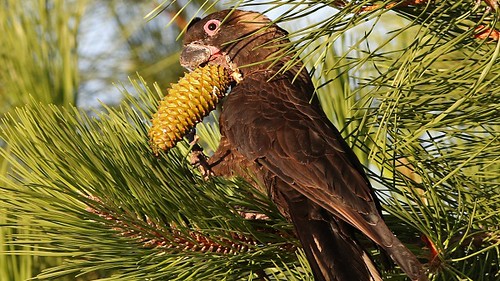Bird lovers take part in sixth annual Great Cocky Count
 Thursday, April 10, 2014 at 23:43
Thursday, April 10, 2014 at 23:43  Keeping tabs on one of WA’s threatened species … a Carnaby’s Black-Cockatoo LAST Sunday, across WA from Esperance to Geraldton, hundreds of volunteers took to select locations just before sunset to take part in what’s known as the Great Cocky Count.
Keeping tabs on one of WA’s threatened species … a Carnaby’s Black-Cockatoo LAST Sunday, across WA from Esperance to Geraldton, hundreds of volunteers took to select locations just before sunset to take part in what’s known as the Great Cocky Count.
Perched in folding chairs, armed with maps, binoculars and clipboards, it was all part of the unique wildlife science project aimed at making a census of WA’s remaining Carnaby’s Black-Cockatoos.
Alison Gye, a member of BirdLife Australia, was one of about 500 volunteers who took part in the count. She and three friends monitored a one-kilometre strip of pine trees north-east of Yanchep.
She says when you’re trying to count cockatoos roosting, it’s wise not to sit under their trees: you won’t get a clear view of them arriving—and you’ll be peppered with pine cones as they feed.
“You can hear them before you see them because they scream and squawk at each other as they fly along,” says Ms Gye.
“It was a lovely clear night, we counted from 5.30pm to 6.30pm—most of them came over in that first half hour when the daylight was good.”
Alison and her friends counted 782 cockatoos at the Yanchep roosting site.
“It was good count, we were pretty stoked,” she says.
The number might sound good, but it’s a fraction of what you might have found a decade ago.
The white-tailed Carnaby’s Black-Cockatoo is only found in south-west Australia but is a threatened species, largely due to habitat clearing.
“I’ve had horses for years and agisted them at various places around Wanneroo,” Alison says.
“You used to see clouds of these cockatoos everywhere, they used to line up on wooden fences and drink in the horses’ water trough around Wanneroo.
“We would see a flock of 2000—you don’t see that anymore. This iconic bird of Perth is disappearing, that’s why I got involved.”
The Great Cocky Count is organised by BirdLife Australia, and funded by the Perth Region NRM.
BirdLife Australia says the number of Carnaby’s Black-Cockatoos has decreased by nearly 50 per cent since 1970 and it’s not known exactly how many remain.
Last year’s Great Cocky Count found more sites and recorded 5,795 cockatoos in the Swan region, an increase of the 2012 figure of 4,036.
The full results of this year’s survey will be collated and released later this year and available at the Great Cocky Count website.

